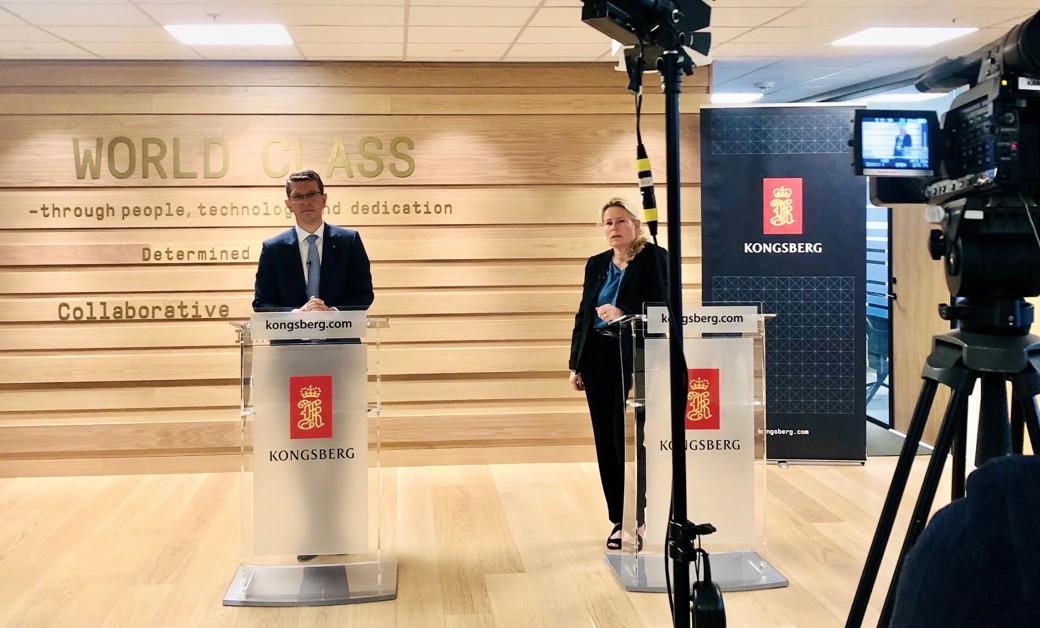The Group’s book-to-bill ratio ended at 1.2, driven by a considerable contract for the delivery of F-35 components and a major contract relating to offshore wind power, which is an interesting segment for KONGSBERG.
1th quarter:
- The order intake was MNOK 7,643 compared to MNOK 6,812 in Q1 2020, an increase of 12.2%
- The operating revenues were MNOK 6,364 compared to MNOK 6,678 in Q1 2020, a drop of 4.7%
- The EBITDA was MNOK 883 compared to MNOK 643 in Q1 2020, an increase of 37.3%
- The EBITDA margin was 13.9% compared to 9.6% in Q1 2020
“The Q1 2021 results confirm the sound developments we’ve seen in the past few years. We’re continuing to grow in the defence sector and are achieving good profitability. Our profit performance in the maritime sector has also been positive, despite the lower revenues linked to the generally challenging vessel newbuilding market. We’re continuing to roll out our digital solutions which show good potential going forward,” says Geir Håøy, the president and CEO of KONGSBERG.
Sound maritime margins and a focus on sustainable solutions
Kongsberg Maritime (KM) is continuing to improve and delivered an 11.2 per cent EBITDA margin during the quarter, up from 8.6 per cent in the first quarter of 2020. This was among other things due to generally stronger operations in this business area, a favourable project composition and lower costs. KM’s book-to-bill ratio was 1.06 for the quarter.
“The maritime market is still demanding, but KM’s margin continue to improve as a result of the measures we have taken. This business area is also maintaining its focus on greener solutions and at the same time the industry is experiencing stricter regulation. That leads to new market opportunities and we see rising interest among customers and partners,” says Håøy.
During the quarter, KM won several contracts in which sustainable technologies play a key role; including a delivery to MS Gann, a maritime training vessel, and the design of and deliveries to a low-emission fish-transport ship for the Sølvtrans shipping company. In addition, this business area signed a MUSD 40 contract for an extensive, integrated technology package for a wind turbine installation vessel (WTIV), ordered by US energy company Dominion Energy.
“Offshore wind power is growing, and in future there will be a need for additional advanced vessels for this market. Our considerable technology base puts us in a strong position in relation to this sector too,” says Håøy.
Growth and a larger order backlog for defence
Kongsberg Defence & Aerospace (KDA) achieved good growth in the first quarter and its revenue increased by 21 per cent compared to the first quarter of 2020. This business area improved its revenue and EBITDA in all divisions. The EBITDA margin ended at 20 per cent, compared to 11.9 per cent in the same quarter last year.
“The good operating profit is a result of solid, efficient project execution and a favourable project composition. We’ve achieved growth in all business areas, have a sound order backlog and are at the same time well positioned for the future. The contract for parts to the F-35 fighter that was signed in March ensures deliveries to 500 aircraft in addition to the 1,000 already regulated by contract. This also puts us in a good position for future production shipments,” says Håøy.
An MNOK 266 contract to upgrade Norway’s NASAMS system was also signed with the Norwegian Defence Material Agency. In addition, KONGSBERG had call-off orders on the frame agreement for delivery of Naval Strike Missiles (NSM) to the US Navy’s Over The Horizon (OTH) programme.
KDA had an order backlog of MNOK 24,470 at the end of the quarter.
Considering future models for KDI
Since being established in 2016, Kongsberg Digital (KD) has become a leading player in several digital segments. Most of KDI’s work is based on a Software as a Service (SaaS) business model, according to which users pay a subscription for services. So far, the SaaS revenues comprise a small but rapidly growing share of KDI’s overall revenues.
“Two important areas of focus for KDI are dynamic digital twins, for which KDI has for instance a significant frame agreement with Shell, and Vessel Insight, a cloud solution for which KDI has agreements with several leading players. Demand for these solutions is growing,” says Håøy.
“KDI’s current phase makes it natural to consider both future partners and other models in order to fully realise the potential that KONGSBERG sees in KDI. This includes considering a stock exchange listing of this business area in time,” he says.
Well positioned for the future
“Players throughout the value chain are showing a fantastic ability to adapt in a situation that we are prepared will affect us the next quarters, too. However, I expect us to continue growing in the defence sector and also in the digital area, since last year has in many ways confirmed and reinforced the need for digital and remote-controlled solutions. The maritime sector markets are still in part very challenging, but we’ve never been better positioned for an upturn in the market. The combined picture show that the Group is standing firm, with positions that provide stability and solid expectations for what lies ahead,” concludes Håøy.
